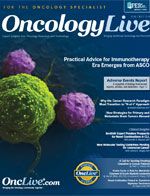Why the Cancer Research Paradigm Must Transition to "N-of-1" Approach
Maurie Markman, MD, discusses how the molecular complexities of cancer necessitate that clinical research evolves beyond the basket trial design.
Maurie Markman, MD
The anticancer clinical research paradigm has rapidly evolved so that subject selection is increasingly based on the presence or absence of a particular molecular biomarker in the individual patient’s malignancy. Even where eligibility does not mandate the presence of specific biological features, tumor samples are commonly collected and an attempt is subsequently made to relate a particular outcome (eg, complete or partial objective response rate; progression-free or overall survival) to the individual cancer’s molecular characteristics.
One important result of this effort has been the recognition that there are an increasing number of patient subsets within what was previously–and incorrectly–considered a much larger homogenous patient population; for example, non—small cell lung cancer (NSCLC) versus EGFR-mutation—positive NSCLC. And, while it may still be possible to conduct phase III randomized trials involving a relatively limited percentage of patients within a large malignant entity, extensive and quite expensive effort may be required to complete this task. For example, the industry-sponsored phase III trial comparing first-line crizotinib with chemotherapy (pemetrexed plus either carboplatin or cisplatin) in ALK-rearrangement—positive NSCLC, which constitutes 3% to 5% of NSCLCs, required an international multicenter effort lasting 2.5 years to accrue the required number of research subjects.1
But what if an investigator, research team, or biotech company desired to examine the clinical utility of an antineoplastic in a patient population representing an even smaller proportion of patients with NSCLC such as in the 1% of the patient population with ROS1 abnormalities,2 or in a larger percentage of patients representing 4%-6% of patients with a less common tumor type such as ovarian cancer? How realistic is it that such a randomized trial could ever be conducted?
Further, considering the resources required to initiate and successfully conduct a multicenter international phase III registration study, it is more than likely that in the near future only the largest pharmaceutical companies will be in a position to definitively test the clinical utility of an antineoplastic in a given clinical situation.
One proposal to begin to explore the benefits of targeted antineoplastics in the setting of specific molecular abnormalities has been to develop a socalled “basket trial” where patients with different types of cancers with varying treatment histories may be permitted entry, assuming a well-defined molecular target is present within their cancer. Of interest, several pharmaceutical companies have initiated such clinical research efforts.
Yet although basket trials represent an important research advance, they may not provide the answer to the molecular complexities of cancer that many investigators believe they will. The research establishment will have to take another step toward innovation to “N-of-1” designs that truly explore the unique nature of each individual’s cancer.
Trial Illustrates Weaknesses
A recent report of the results of one multicenter basket trial focused on thoracic cancers demonstrates both the strengths but also a major fundamental weakness of the basket trial approach.3
In the trial, the tumors of 647 patients with NSCLC, small cell lung cancer, or thymic malignancies underwent genomic analysis in a search for potentially actionable molecular abnormalities. As anticipated, approximately one-fifth of the cancers (22.1%) in the NSCLC cohort contained an EGFR mutation and the objective response rate to erlotinib, employed in the trial for this particular molecular abnormality, was 60%. A similarly large group of patients with NSCLC with KRAS mutations (24.9%) were treated with selumetinib but the objective response rate was a disappointing 11%.3 In both situations, the basket trial concept succeeded in accruing an adequate number of patients to test a hypothesis of whether “drug A” would be biologically and clinically active in a specific setting.
However, the investigators were forced to conclude that despite accrual of more than 600 patients onto a study conducted at two centers over a period of approximately 2 years, “this basket trial design was not feasible for many of the arms with rare mutations.”3
They concluded that they needed a larger number of participating institutions and the ability to adapt the design for different drugs and mutations. So the question to be asked is as follows: Is the basket-type approach the only alternative to evaluate the clinical relevance of a targeted antineoplastic in the presence of a specific molecular abnormality?
Of course, the correct answer to this question is surely: No!
With the increasingly widespread commercial availability of CLIA-approved somatic genomic testing, it should be possible to explore the utility of these agents within the far larger population of patients treated in the nonacademic setting by community oncologists with the results of treatment, both efficacy and toxicity, being reported in publicly available databases.
In this scenario, the security of the data and individual patient privacy must be maintained, but it is highly likely that patients would be willing to give permission to have their identity-scrubbed outcome results included in such a database, knowing that they will or may have personally benefited from the information other patients had previously provided to this effort.
As a result, it should be anticipated that a 600-patient study that concluded the “non-feasibility of the trial design” to answer the question of clinical utility could very easily be converted to a 6000-plus “N-of-1” research database where ultimately targeted therapeutic strategies can be examined in the setting of even the most uncommon molecular abnormalities.
References
- Solomon BJ, Mok T, Kim D-W, et al. First-line crizotinib versus chemotherapy in ALK-positive lung cancer. N Engl J Med. 2014;371(23):2167-2177.
- Mazières J, Zalcman G, Crinò L, et al., Crizotinib therapy for advanced lung adenocarcinoma and a ROS1 rearrangement: results from the EUROS1 cohort [published online February 9, 2015]. J Clin Oncol. 2015;33(9):992-999.
- Lopez-Chavez A, Thomas A, Rajan A, et al. Molecular profiling and targeted therapy for advanced thoracic malignancies: a biomarker- derived, multiarm, multihistology phase II basket trial [published online February 9, 2015]. J Clin Oncol. 2015;33(9):1000-1007.




